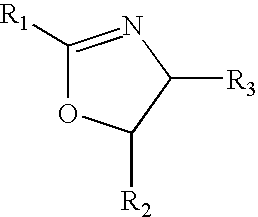Wood Adhesives Comprising Protein and Oxazoline Polymer or Resin
- Summary
- Abstract
- Description
- Claims
- Application Information
AI Technical Summary
Benefits of technology
Problems solved by technology
Method used
Image
Examples
example 1
Soy Flour / Oxazoline Functional Latex Binder
[0071]Binder A: Soy flour / oxazoline functional latex wet blends were prepared by first diluting 30 grams of a commercial oxazoline functional latex comprising the polymerization product of ˜20% isopropenyl oxazoline (40 wt. % solids), Epocros™ K-2020E (Nippon Shokubai, Osaka, Japan) with 78 grams water. This mixture was agitated using an overhead stirrer equipped with a propeller stirrer at a speed sufficient to create a vortex and 20 grams of Soy flour (Cargill Prolia 100 / 90, Minneapolis, Minn.), was then added portion-wise with stirring to the mixture to make Binder A. The pH of the resulting mixture was 6.5. Water was added to adjust final binder solids to 25%. Blends at different pH's were obtained by adding aqueous solutions of sulfuric acid or sodium hydroxide to the blend prior to final solids adjustment.
[0072]A control binder of soy flour alone was prepared in a similar fashion. A standard urea formaldehyde (UF) resin control binder...
example 2
Soy Flour / Oxazoline Functional Aqueous Solution Polymer Binder
[0075]Particleboard furnish / binder blends were prepared by first charging 350 grams of wood furnish (FP Innovations-Forintek Division) and 25 grams of dry soy flour (Cargill Prolia 100 / 90) into a kitchen-style mixing bowl. The bowl was placed onto a kitchen mixer (Kitchen Aid, Artisan model), and gentle agitation was provided using a 3-blade paddle. Diluted (25%) aqueous sulfuric acid, 0.23 grams, was added to the stirring mixture. To Make Binder B in situ with wood, 5.3 grams of a commercial oxazoline functional aqueous solution polymer having an Mn of 2,700 made from polymerization of 50 wt. % of isopropenyl oxazoline, Epocros WS-700 (Nippon Shokubai), was diluted with 54 grams of water and added by pipette to the acidified wood / soy flour mixture. The final mixture contained a binder solids weight of 8% (based on dry binder weight and wood solids weight) with a soy flour to WS-700 dry weight ratio of 95:5. The final moi...
example 3
Lignosulfonate / Oxazoline Functional Aqueous Solution Polymer Binder
[0078]Particleboard furnish / binder blends were prepared by first charging 350 grams of wood furnish (American Wood Fibers, Columbia, Md.) into a kitchen-style mixing bowl. The bowl was placed onto a kitchen mixer (Kitchen Aid, Artisan model), and gentle agitation was provided using a 3-blade paddle. Diluted (25%) aqueous sulfuric acid, 4.8 grams, was added to the stirring wood furnish. To make Binder C in situ with the wood, 33 grams of Lignosulfonate (Arbo™ S01 Tembec Inc. Montreal, Canada) and the commercial oxazoline functional aqueous solution polymer, Epocros WS-700 (Nippon Shokubai), 40 grams, were each diluted with about 15 grams of water and added sequentially by pipette to the acidified wood furnish. Binder C contained a binder solids weight of 8% (based on dry binder weight and dry wood weight) with a lignosulfonate to WS-700 dry weight ratio of 62.5:37.5. The final moisture content was approximately 22%.
[0...
PUM
| Property | Measurement | Unit |
|---|---|---|
| Acidity | aaaaa | aaaaa |
| Weight ratio | aaaaa | aaaaa |
| Density | aaaaa | aaaaa |
Abstract
Description
Claims
Application Information
 Login to View More
Login to View More - R&D
- Intellectual Property
- Life Sciences
- Materials
- Tech Scout
- Unparalleled Data Quality
- Higher Quality Content
- 60% Fewer Hallucinations
Browse by: Latest US Patents, China's latest patents, Technical Efficacy Thesaurus, Application Domain, Technology Topic, Popular Technical Reports.
© 2025 PatSnap. All rights reserved.Legal|Privacy policy|Modern Slavery Act Transparency Statement|Sitemap|About US| Contact US: help@patsnap.com

